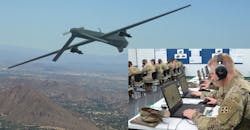Unmanned ground vehicles (UGVs) and unmanned aerial vehicles (UAVs) will soon play a major role in robotically controlled battlefields, to the extent that U.S. Army researchers want to develop electronic technologies for the next-generation combat-vehicle cross-functional team in a video game environment.
As Brig. Gen. Ross Coffman, NGCV CFT director, said: “This latest experiment will provide us with an understanding of which technologies are most critical for the robotic combat vehicle to be successful in an operational environment.” As part of the experiments, 30 soldiers from the Fourth Infantry Division recently tested the different technologies to help the soldiers learn what was needed for efficient control of manned and unmanned electronic tools. It is hoped that such testing and research practices will help the Army develop better systems without having to step into the field and into combat.
The five-day research explored how soldiers best operated in different system and equipment configurations and crew configurations and how soldiers worked with different types of constraint equipment. The virtual experiments used remotely controlled vehicles (RCVs) against a simulated near-peer adversary. They also studied how companion technologies such as tethered UAVs, target recognition and designation, and smoke generation in support of an RCV.
“One of the things we are looking at is if a lighter, less-protected RCV can achieve similar battlefield effect as a heavier but more protected one, while both having the same lethality package. These Soldier touch points are essential to how Army Futures Command is executing the Army’s modernization priority,” Coffman explained. “Soldiers are at the center of everything we do, and their insight is crucial to developing these new technologies.”
About the Author
Jack Browne
Technical Contributor
Jack Browne, Technical Contributor, has worked in technical publishing for over 30 years. He managed the content and production of three technical journals while at the American Institute of Physics, including Medical Physics and the Journal of Vacuum Science & Technology. He has been a Publisher and Editor for Penton Media, started the firm’s Wireless Symposium & Exhibition trade show in 1993, and currently serves as Technical Contributor for that company's Microwaves & RF magazine. Browne, who holds a BS in Mathematics from City College of New York and BA degrees in English and Philosophy from Fordham University, is a member of the IEEE.

